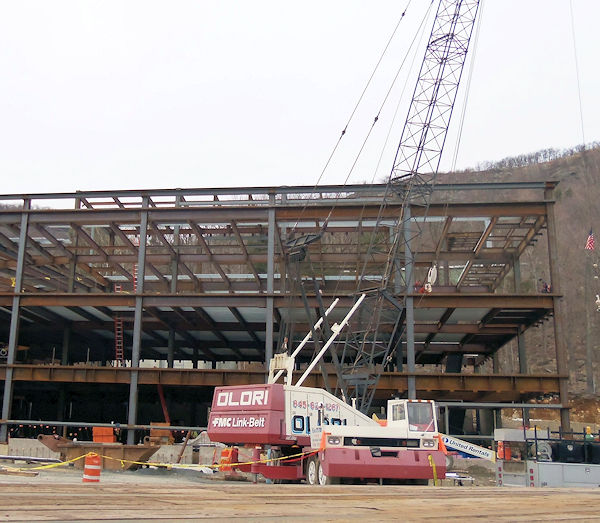28.B.14 Walking/working surfaces.
- Shear connectors and other similar devices.
- (1) Tripping hazards. Shear connectors (such as headed steel studs, steel bars, or steel lugs), reinforcing bars, deformed anchors or threaded studs must not be attached to the top flanges of beams, joists, or beam attachments so that they project vertically from or horizontally across the top flange of the member until after the metal decking, or other walking/working surface, has been installed.
- (2) Installation of shear connectors on composite floors, roofs, and bridge decks. When shear connectors are used in construction of composite floors, roofs, and bridge decks, employees must lay out and install the shear connectors after the metal decking has been installed, using the metal decking as a working platform.
- Bracing.
- (1) When deemed necessary by a CP, temporary erection bracing equipment must be installed in conjunction with the steel erection process to ensure the stability of the structure.
- (2) When used, bracing equipment must be in place and properly installed before the structure is loaded with construction material such as loads of joists, bundles of decking, or bundles of bridging.
- (3) Bracing equipment must be removed only with the approval of a CP.
- Metal decking - Hoisting, landing, and placing of metal decking bundles.
- (1) Bundle packaging and strapping must not be used for hoisting unless specifically designed for that purpose.
- (2) If loose items such as dunnage, flashing, or other materials are placed on the top of metal decking bundles to be hoisted, such items must be secured to the bundles.
- (3) Bundles of metal decking on joists must be landed in accordance with Section 28.B.26.
- (4) Metal decking bundles must be landed on framing members so that enough support is provided to allow the bundles to be unbanded without dislodging the bundles from the supports.
- (5) At the end of the shift or when environmental or jobsite conditions require, metal decking must be secured against displacement.
- (6) Roof and floor holes and openings. Metal decking at roof and floor holes and openings must be installed as follows:
- (a) Framed metal deck openings must have structural members turned down to allow continuous deck installation except where not allowed by structural design constraints or constructability.
- (b) Roof and floor holes and openings must be decked over or protected in accordance with Section 24.
- (c) Metal decking holes and openings must not be cut until immediately prior to being permanently filled with the equipment or structure needed or intended to fulfill its specific use and that meets the strength requirements of Section 24, or must be immediately covered or guarded.
28.B.15 Installation of metal decking.
- Metal decking must be laid tightly and secured upon placement to prevent accidental movement or displacement. A maximum of 3,000 ft2 (278.7 m2) may be laid before securing.
- During initial placement metal-decking panels must be placed to ensure full support by structural members.
28.B.16 Derrick floors.
- A derrick floor must be fully decked and/or planked and the steel member connections completed to support the intended floor loading.
- Temporary loads placed on a derrick floor must be distributed over the underlying support members so as to prevent local overloading of the deck material.
Knowledge Check Choose the best answer for the question.
28-4. How much metal decking may be laid before it must be secured to prevent movement or displacement?
You forgot to answer the question!


